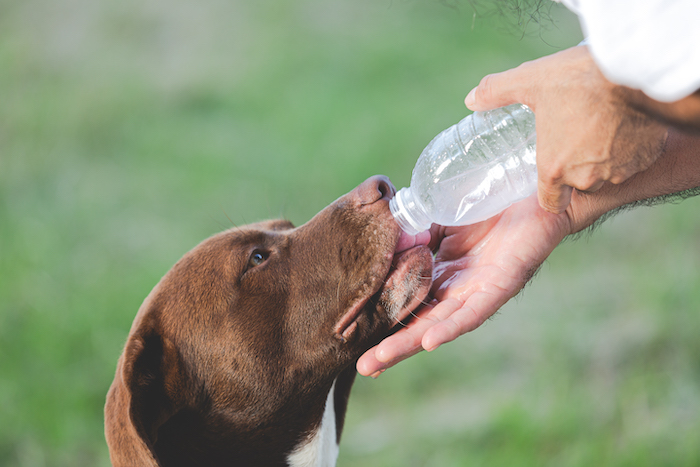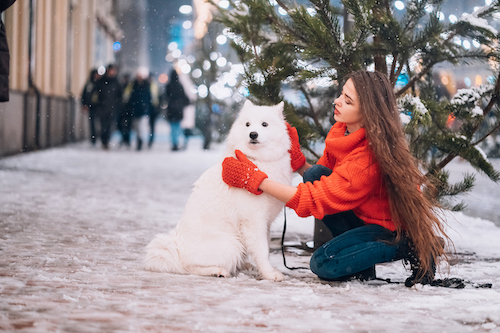
EcoGrit Ice Melt | Safe for Children and Pets, Any Surface | Non-Toxic Light-Weight Easy Application | Protects from Snow and Ice for up to a week.
EcoGrit provides a fantastic ice melt that is environment-friendly and pet-friendly

When the weather turns to frost and snow, Much thought is given to ways to stop people and pets from slipping and sliding as they walk along. A common method that many people use is spreading rock salt to add traction and help the ice to melt away. However, what seems at first to be an effective solution for melting snow, can actually end up causing more problems than it solves – especially when it comes to our canine friends and their feet.
Dogs’ paws are delicate underneath and can easily become irritated, injured or sore when they are exposed to something harmful underfoot. Rock salt contains sodium chloride, which can irritate the pads on canine paws and cause digestion and stomach issued if ingested, e.g. if the dog licks his paws to get rid of the salt. Dogs can also walk the slat indoors, causing damage to carpets and flooring, as well a spreading the risk of other pets swallowing it and becoming unwell as a result.
The good news is that there are plenty of ways to reduce the risk of your dog being exposed to rock salt. From choosing different routes for the daily walk to investing in dog-friendly ice melt, here’s how to keep man’s best friend safer and healthier this winter.

Even without the risk of rock salt becoming embedded in your dog’s paws, winter walks can come with additional risks. Check the paws after every walk or time spent outside for any trapped salt grains or debris, cuts and evidence of soreness or irritation. Gently wash your dog’s feet when you get home, patting them dry with a towel. You might like to add a thin layer of petroleum jelly or a similar barrier before taking your dog outside. You can also get specialist dog booties for your pet to wear for added protection and warmth.
If your usual walking routes take you past a lot of treated paths, pavements and driveways that could have rock salt on them, try walking somewhere else for a while to give your dog a break. Go for more rural spots, where the roads etc. may not have been treated quite so assiduously with rock salt, or other non-dog-friendly salt products. Good places to try if you can’t reach the countryside so easily are parks, gardens and fields (check dogs are allowed in these places first), where they can enjoy walking and playing in softer, untrodden snow.

Don’t let your dog drink from puddles or streams in colder weather, as rock salt from treated frost and ice may have run off into pools of water, where it will cause harm if swallowed. Always carry your own water supply and some treats for your dog during a walk so that you can give him what he needs at any point along the route. Equally, take a blanket or towel to clean him off if he gets muddy, rather than allowing him to wash in potentially salty water. While on the topic of drinking, watch out for signs of dehydration as dogs use up extra energy staying warm in the winter and may need extra food and water to help him with this.

One particularly effective way to protect your canine companion when out and about in the winter is to use a pet-friendly ice melting product like EcoGrit that does not contain any rock salt, urea or other harmful ingredients to grit your own driveway, paths and garden. This gives your dog a wider area to run about safely, while still enabling you to clear ice and snow effectively and safely, down to -20°C. It works for up to seven days, meaning that you don’t need to use so much, and it is safe if pets accidentally ingest it. It’s biodegradable too, meaning that you can extend your love of animals to the wider ecological habitats around your home, garden and locality.
Finally, if you provide your dog with plenty of room for plating, eating, sleeping and generally enjoying life indoors, he won’t have to rely on being outside for his daily living requirements. Make him a safe, comfortable place to sleep and have separate eating areas and lots of toys to play with to keep his body and mind active, whatever the weather.
EcoGrit
20 Harbour View
Truro
Cornwall
TR1 1XJ

EcoGrit provides a fantastic ice melt that is environment-friendly and pet-friendly

With the return of winter and the inevitable widespread use of rock salt gritting, the RSPCA is warning to check pets’ paws and fur if






EcoGrit is an environmentally conscious company that would like to serve the people by offering them education, insight, “peace of mind” and the chance to make a positive difference on a monumental scale at a time when winter weather patterns are becoming more unpredictable.
VAT (Value Added Tax) Number: 340 3662 26
EcoGrit provides a fantastic ice melt that is environment-friendly and pet-friendly
© 2023 EcoGrit Ltd